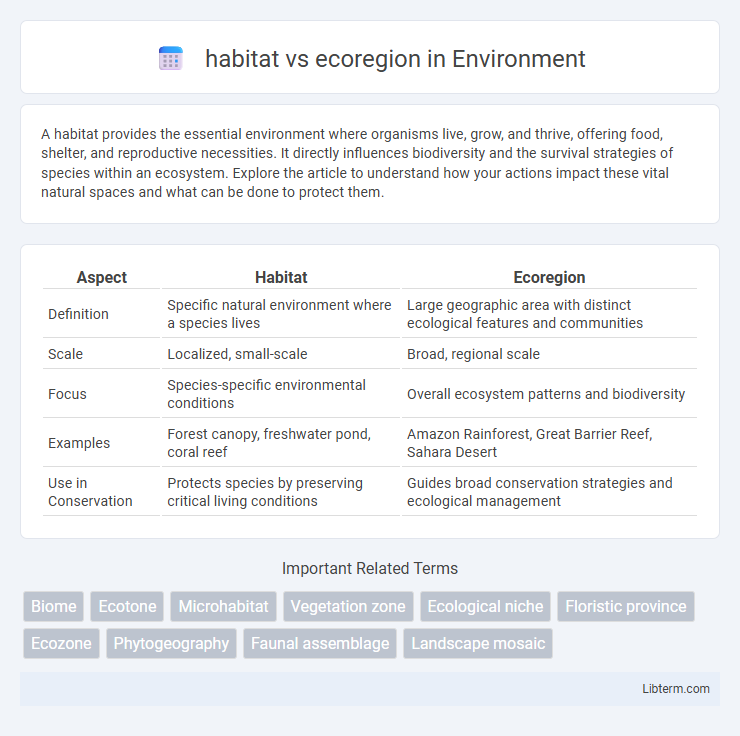A habitat provides the essential environment where organisms live, grow, and thrive, offering food, shelter, and reproductive necessities. It directly influences biodiversity and the survival strategies of species within an ecosystem. Explore the article to understand how your actions impact these vital natural spaces and what can be done to protect them.
Table of Comparison
| Aspect | Habitat | Ecoregion |
|---|---|---|
| Definition | Specific natural environment where a species lives | Large geographic area with distinct ecological features and communities |
| Scale | Localized, small-scale | Broad, regional scale |
| Focus | Species-specific environmental conditions | Overall ecosystem patterns and biodiversity |
| Examples | Forest canopy, freshwater pond, coral reef | Amazon Rainforest, Great Barrier Reef, Sahara Desert |
| Use in Conservation | Protects species by preserving critical living conditions | Guides broad conservation strategies and ecological management |
Introduction to Habitat and Ecoregion
Habitat refers to the specific natural environment where a particular species or group of organisms live, providing essential resources such as food, shelter, and breeding grounds. Ecoregion encompasses larger geographic areas characterized by distinct ecological features, climate, and biodiversity patterns that influence the distribution of multiple habitats within their boundaries. Understanding both habitat and ecoregion is crucial for effective conservation planning and the management of natural resources across varying spatial scales.
Defining Habitat: Key Characteristics
Habitat refers to the specific natural environment where an organism lives, characterized by factors such as climate, vegetation, soil type, and availability of food and water. It provides the essential conditions required for species survival and reproduction, including shelter and breeding sites. Unlike ecoregions, habitats are more localized and directly influence the behavior and adaptation of individual species.
What is an Ecoregion?
An ecoregion is a large, geographically distinct area characterized by a specific climate, soil, and biodiversity, including unique plant and animal communities. Unlike habitats, which are smaller environments where individual species live, ecoregions encompass multiple habitats within their boundaries. Ecoregions provide a framework for conservation efforts by capturing ecological patterns at a regional scale, facilitating sustainable management of natural resources.
Differences Between Habitat and Ecoregion
Habitat refers to the specific natural environment where a particular species lives and thrives, characterized by factors such as climate, vegetation, and availability of resources. Ecoregion, on the other hand, is a larger geographic area that encompasses multiple habitats sharing similar ecological features, climate patterns, and biodiversity. The key difference lies in scale and scope: habitat is species-specific and localized, while ecoregion covers broader spatial zones with distinct communities of plants and animals.
Examples of Habitats and Ecoregions
Tropical rainforests, coral reefs, and deserts represent distinct habitats characterized by specific climate conditions and species adaptations. Ecoregions like the Amazon Basin, Great Barrier Reef, and Sahara Desert encompass these habitats, defined by their unique ecological patterns and biotic communities. Each ecoregion integrates multiple habitats sharing similar environmental traits and biodiversity dynamics.
Importance of Habitats in Biodiversity
Habitats provide the essential physical environment and resources necessary for species to survive and reproduce, directly influencing biodiversity maintenance and ecosystem stability. Unlike ecoregions, which classify areas based on broader ecological patterns and climatic conditions, habitats focus on specific living conditions crucial for supporting diverse flora and fauna populations. Protecting diverse habitats is vital for preserving genetic diversity, enabling species adaptation, and sustaining ecological processes critical to global biodiversity health.
Role of Ecoregions in Conservation
Ecoregions provide a geographic framework that defines large areas of similar ecological systems, enabling targeted conservation efforts based on shared climate, geology, and biodiversity patterns. They facilitate prioritizing habitats that require protection by identifying regions with unique species assemblages and high endemism, thus guiding resource allocation efficiently. Protecting ecoregions supports ecosystem services and resilience by maintaining ecological processes at a landscape scale beyond isolated habitats.
How Scientists Classify Habitats and Ecoregions
Scientists classify habitats based on the physical environment and the species living there, focusing on factors such as climate, vegetation, and soil type. Ecoregions are defined by broader ecological patterns, encompassing multiple habitats that share similar climate, biodiversity, and ecosystem processes. Classification systems like the World Wildlife Fund's ecoregions map integrate climatic data, species distribution, and landscape features to delineate these regions for conservation and ecological research.
Human Impact on Habitats and Ecoregions
Human activities such as deforestation, urbanization, and pollution significantly alter habitats, leading to habitat fragmentation and loss of biodiversity. Ecoregions, defined by distinct climate and ecological patterns, experience shifts in species composition and ecosystem functions due to these anthropogenic pressures. Conservation efforts targeting habitat restoration and sustainable land use within ecoregions are critical to mitigating human-induced environmental degradation.
Protecting Habitats vs. Ecoregions: Conservation Strategies
Protecting habitats targets specific natural environments crucial for the survival of individual species, ensuring biodiversity at a localized scale. In contrast, conserving ecoregions addresses broader ecological patterns and processes, preserving interconnected ecosystems that support multiple habitats and species. Effective conservation strategies integrate habitat protection within the larger context of ecoregion management to maintain ecosystem resilience and function.
habitat Infographic

 libterm.com
libterm.com